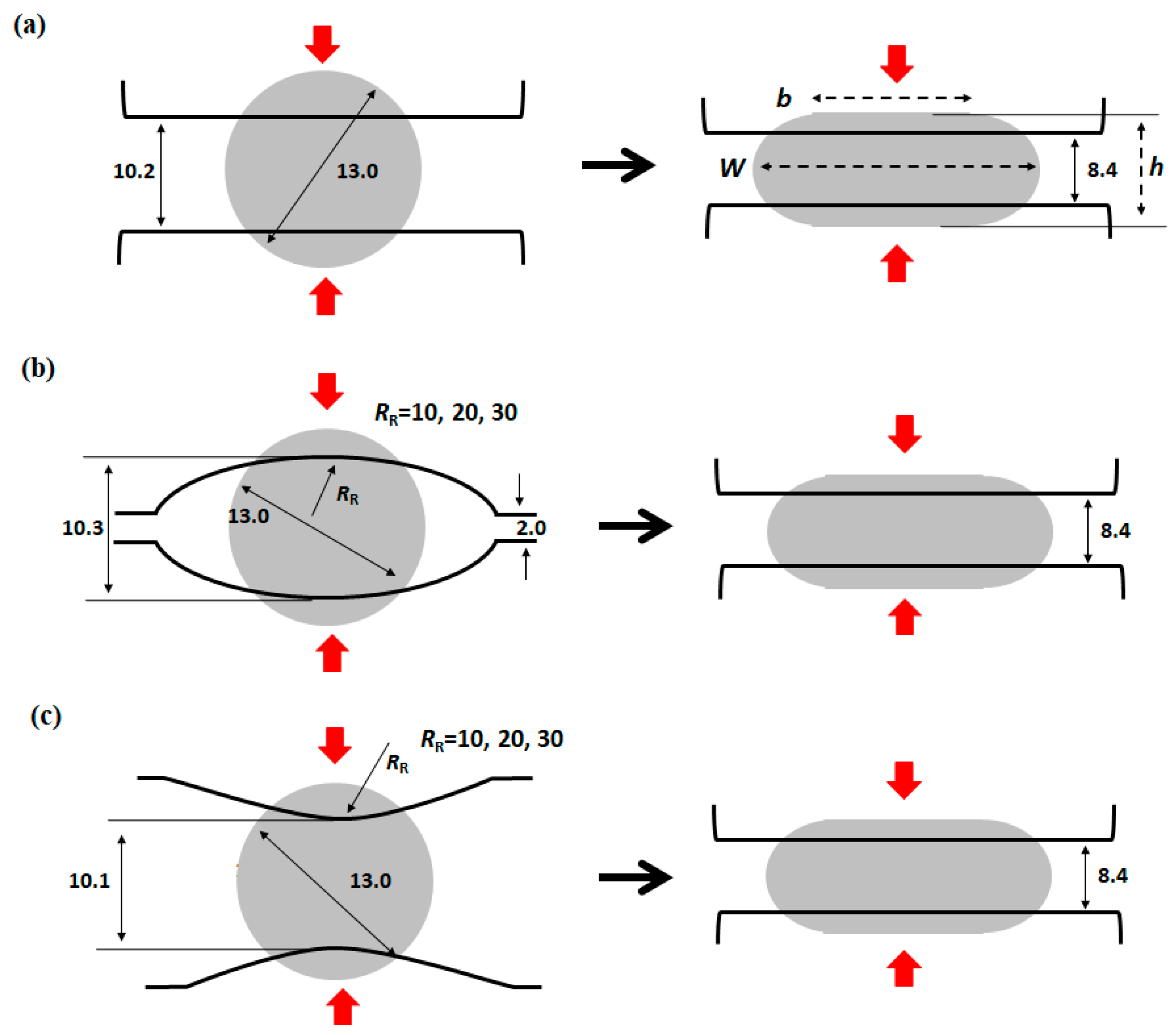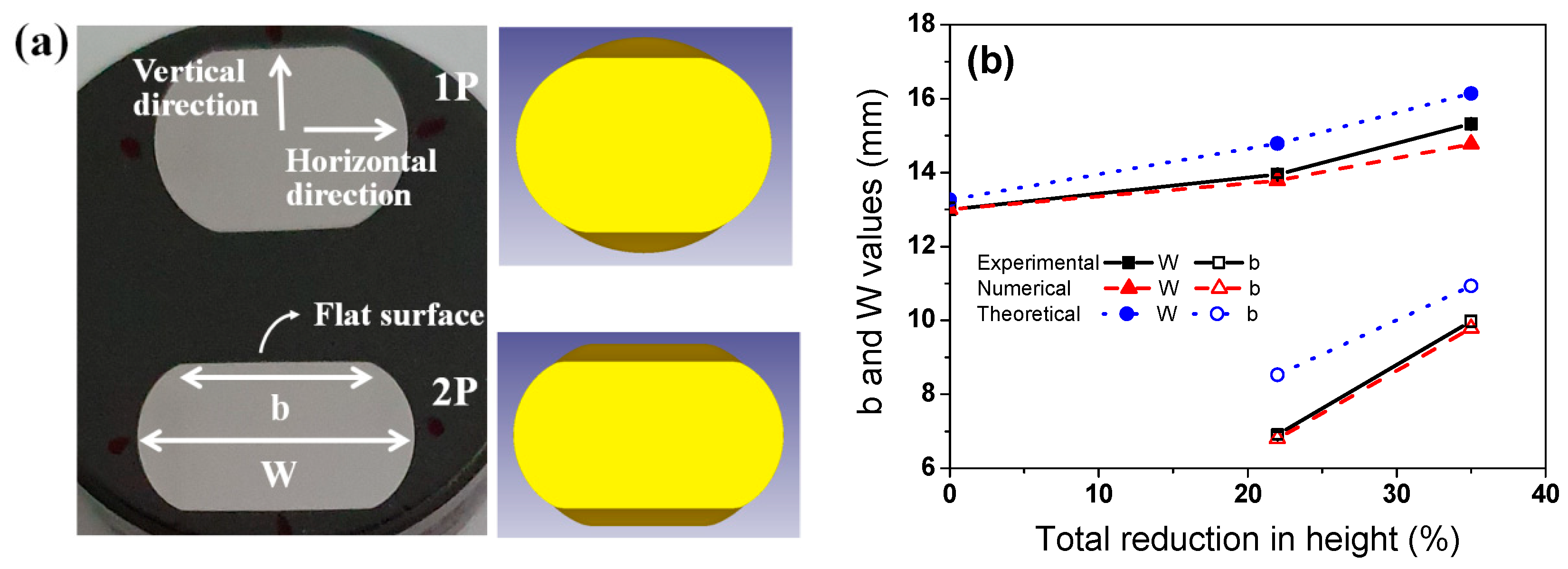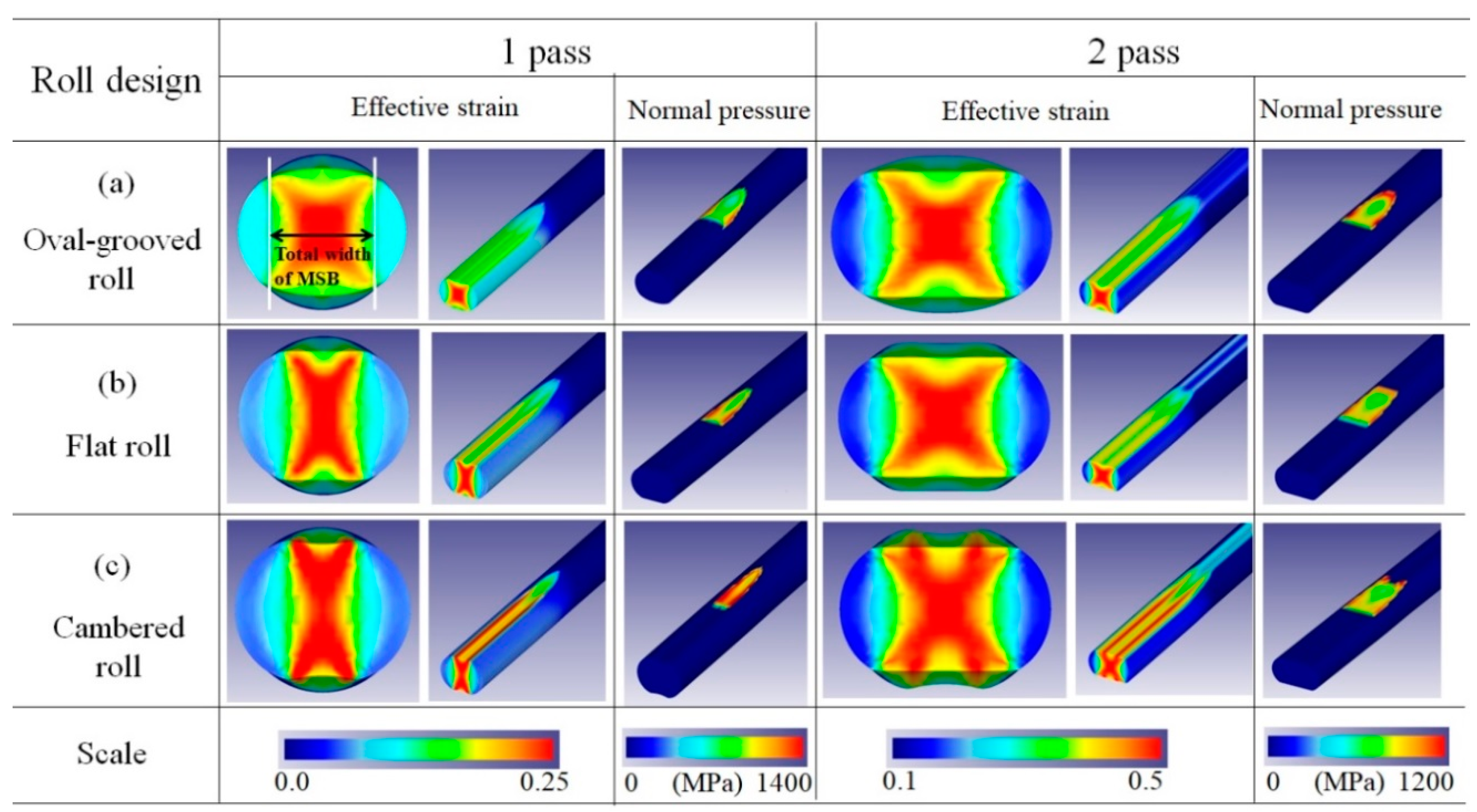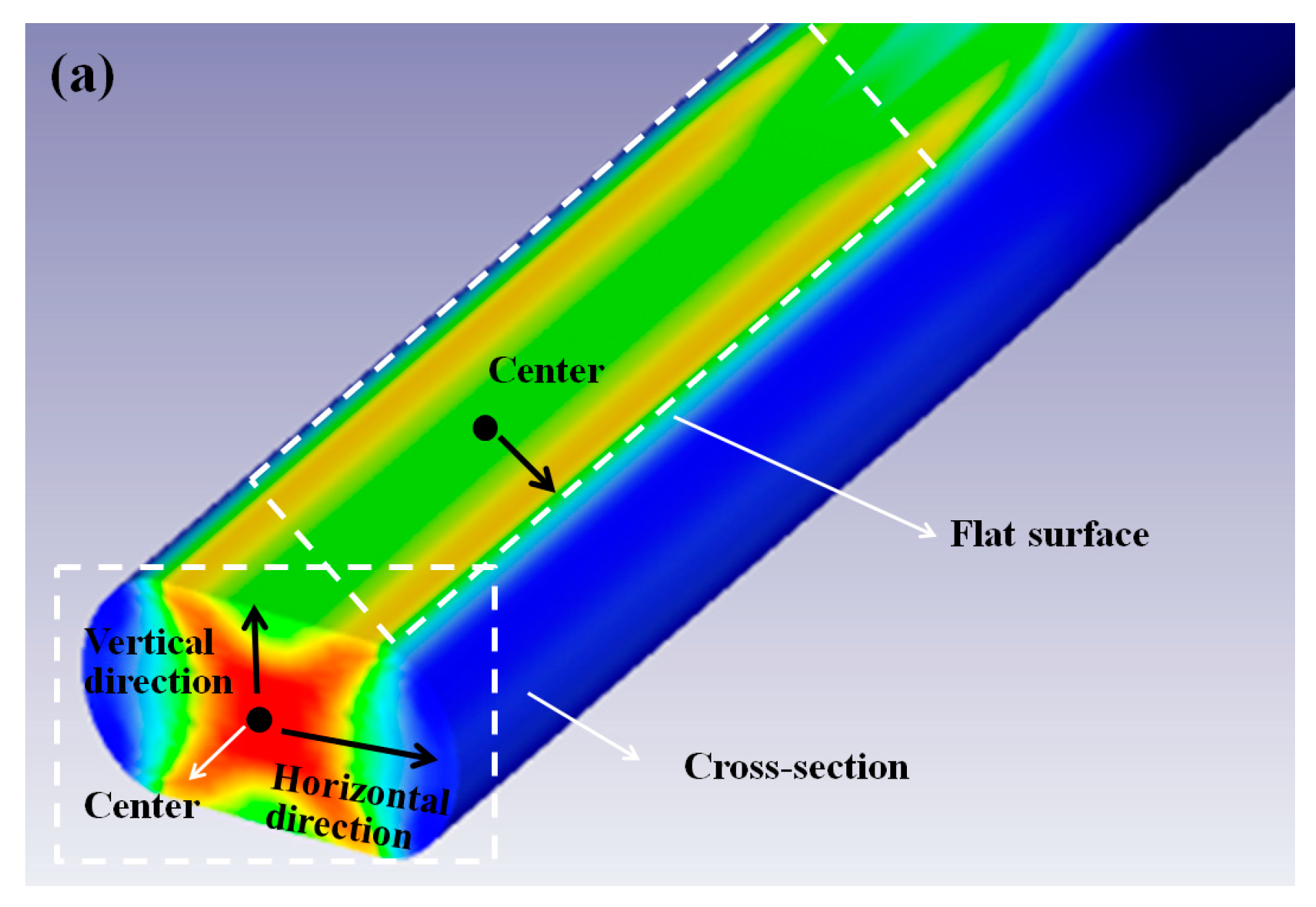Effect of Cambered and Oval-Grooved Roll on the Strain Distribution During the Flat Rolling Process of a Wire
Abstract
1. Introduction
2. Numerical Procedures
3. Validation of the Numerical Model
4. Results and Discussion
4.1. Strain Distribution with Roll Design
4.2. Shape of Flat-Rolled Wire with Roll Design
4.3. Design Concept for a High-Quality Flat-Rolled Wire
5. Conclusions
- The effective strain on the flat surface of the wire increased when using a cambered roll due to the highly intensified contact pressure, while the effective strain on the flat surface of the wire decreased when using an oval-grooved roll;
- The b and W values decreased when using an oval-grooved roll with a small radius because the spread in the free surface area of the wire was highly restricted by the roll shape. In contrast, the spread in the surface area increased when using a cambered roll due to the less-restricted metal flow at the free surface;
- A new practical strategy was proposed for fabricating high-quality flat-rolled wires. A cambered roll with a small radius can improve the surface quality of flat-rolled wires. This is beneficial for industrial plants because cambered rolls can be applied easily in flat rolling plants.
Funding
Conflicts of Interest
References
- Kazeminezhad, M.; Karimi Taheri, A. A theoretical and experimental investigation on wire flat rolling process using deformation pattern. Mater. Des. 2005, 26, 99–103. [Google Scholar] [CrossRef]
- Kobayashi, K.; Asakawa, M.; Kobayashi, M. Deformation behavior of round wire in compression using a cylindrical tool and the analysis of width spreading in flat rolling. Wire J. Int. 2005, 38, 74–79. [Google Scholar]
- Kazeminezhad, M.; Taheri, A.K. An experimental investigation on the deformation behavior during wire flat rolling process. J. Mater. Process. Technol. 2005, 160, 313–320. [Google Scholar] [CrossRef]
- Kazeminezhad, M.; Taheri, A.K.; Tieu, A.K. A study on the cross-sectional profile of flat rolled wire. J. Mater. Process. Technol. 2008, 200, 325–330. [Google Scholar] [CrossRef]
- Massé, T.; Chastel, Y.; Montmitonnet, P.; Bobadilla, C.; Persem, N.; Foissey, S. Impact of mechanical anisotropy on the geometry of flat-rolled fully pearlitic steel wires. J. Mater. Process. Technol. 2011, 211, 103–112. [Google Scholar] [CrossRef]
- Utsunomiya, H.; Hartley, P.; Pillinger, I. Three-Dimensional Elastic-Plastic Finite-Element Analysis of the Flattening of Wire Between Plain Rolls*. J. Manuf. Sci. Eng. 2000, 123, 397–404. [Google Scholar] [CrossRef]
- Parvizi, A.; Pasoodeh, B.; Abrinia, K.; Akbari, H. Analysis of curvature and width of the contact area in asymmetrical rolling of wire. J. Manuf. Process. 2015, 20, 245–249. [Google Scholar] [CrossRef]
- Kazeminezhad, M.; Taheri, A.K. The prediction of macroscopic shear bands in flat rolled wire using the finite and slab element method. Mater. Lett. 2006, 60, 3265–3268. [Google Scholar] [CrossRef]
- Kazeminezhad, M.; Taheri, A.K. Deformation inhomogeneity in flattened copper wire. Mater. Des. 2007, 28, 2047–2053. [Google Scholar] [CrossRef]
- Kazeminezhad, M.; Taheri, A.K. The effect of 3D and 2D deformations on flattened wires. J. Mater. Process. Technol. 2008, 202, 553–558. [Google Scholar] [CrossRef]
- Massé, T.; Chastel, Y.; Montmitonnet, P.; Bobadilla, C.; Persem, N.; Foissey, S. Mechanical and damage analysis along a flat-rolled wire cold forming schedule. Int. J. Mater. Form. 2011, 5, 129–146. [Google Scholar] [CrossRef]
- Vallellano, C.; Cabanillas, P.; García-Lomas, F. Analysis of deformations and stresses in flat rolling of wire. J. Mater. Process. Technol. 2008, 195, 63–71. [Google Scholar] [CrossRef]
- Iankov, R. Finite element simulation of profile rolling of wire. J. Mater. Process. Technol. 2003, 142, 355–361. [Google Scholar] [CrossRef]
- Hwang, J.-K. Deformation Behaviors of Flat Rolled Wire in Twinning-Induced Plasticity Steel. Met. Mater. Int. 2019, 26, 603–616. [Google Scholar] [CrossRef]
- Paul, H.; Driver, J.; Tarasek, A.; Wajda, W.; Miszczyk, M. Mechanism of macroscopic shear band formation in plane strain compressed fine-grained aluminium. Mater. Sci. Eng. A 2015, 642, 167–180. [Google Scholar] [CrossRef]
- Eom, J.; Son, Y.; Jeong, S.; Ahn, S.; Jang, S.; Yoon, D.; Joun, M. Effect of strain hardening capability on plastic deformation behaviors of material during metal forming. Mater. Des. 2014, 54, 1010–1018. [Google Scholar] [CrossRef]
- Lambiase, F.; Di Ilio, A. Deformation inhomogeneity in roll drawing process. J. Manuf. Process. 2012, 14, 208–215. [Google Scholar] [CrossRef]
- Inoue, T. Optimum pass design of bar rolling for production bulk ultrafine-grained steel by numerical simulation. Mat. Sci. Forum 2010, 654–656, 1561–1564. [Google Scholar] [CrossRef]
- Hwang, J.-K.; Kim, S.J. Effect of reduction in area per pass on strain distribution and microstructure during caliber rolling in twinning-induced plasticity steel. J. Iron Steel Res. Int. 2019, 27, 62–74. [Google Scholar] [CrossRef]
- Choung, J.; Cho, S.R. Study on true stress correction from tensile tests. J. Mech. Sci. Technol. 2008, 22, 1039–1051. [Google Scholar] [CrossRef]
- Koc, P.; Štok, B. Computer-aided identification of the yield curve of a sheet metal after onset of necking. Comput. Mater. Sci. 2004, 31, 155–168. [Google Scholar] [CrossRef]
- Hwang, J.-K.; Yi, I.-C.; Son, I.-H.; Yoo, J.-Y.; Kim, B.; Zargaran, A.; Kim, N.J. Microstructural evolution and deformation behavior of twinning-induced plasticity (TWIP) steel during wire drawing. Mater. Sci. Eng. A 2015, 644, 41–52. [Google Scholar] [CrossRef]
- Hwang, J.-K. The microstructure dependence of drawability in ferritic, pearlitic, and TWIP steels during wire drawing. J. Mater. Sci. 2019, 54, 8743–8759. [Google Scholar] [CrossRef]
- Carlsson, B. The contact pressure distribution in flat rolling of wire. J. Mater. Process. Technol. 1998, 73, 1–6. [Google Scholar] [CrossRef]
- Kazeminezhad, M.; Taheri, A.K. Calculation of the rolling pressure distribution and force in wire flat rolling process. J. Mater. Process. Technol. 2006, 171, 253–258. [Google Scholar] [CrossRef]
- Kwon, H.-C.; Lee, Y.; Im, Y. Experimental and Numerical Prediction of Austenite Grain Size Distribution in Round-oval Shape Rolling. ISIJ Int. 2003, 43, 1967–1975. [Google Scholar] [CrossRef][Green Version]
- Jung, K.; Lee, H.W.; Im, Y.-T. A microstructure evolution model for numerical prediction of austenite grain size distribution. Int. J. Mech. Sci. 2010, 52, 1136–1144. [Google Scholar] [CrossRef]
- Hwang, J.-K. Effects of caliber rolling on microstructure and mechanical properties in twinning-induced plasticity (TWIP) steel. Mater. Sci. Eng. A 2018, 711, 156–164. [Google Scholar] [CrossRef]









| Roll Design | Values | ||
|---|---|---|---|
| Surface Radius (mm) | RR | IRD | |
| Oval-grooved roll | 10 | 10 | 1.3 |
| 20 | 20 | 0.65 | |
| 30 | 30 | 0.43 | |
| Flat roll | ∞ | ∞ | 0 |
| Cambered roll | 30 | −30 | −0.43 |
| 20 | −20 | −0.65 | |
| 10 | −10 | −1.3 | |
© 2020 by the author. Licensee MDPI, Basel, Switzerland. This article is an open access article distributed under the terms and conditions of the Creative Commons Attribution (CC BY) license (http://creativecommons.org/licenses/by/4.0/).
Share and Cite
Hwang, J.-K. Effect of Cambered and Oval-Grooved Roll on the Strain Distribution During the Flat Rolling Process of a Wire. Processes 2020, 8, 876. https://doi.org/10.3390/pr8070876
Hwang J-K. Effect of Cambered and Oval-Grooved Roll on the Strain Distribution During the Flat Rolling Process of a Wire. Processes. 2020; 8(7):876. https://doi.org/10.3390/pr8070876
Chicago/Turabian StyleHwang, Joong-Ki. 2020. "Effect of Cambered and Oval-Grooved Roll on the Strain Distribution During the Flat Rolling Process of a Wire" Processes 8, no. 7: 876. https://doi.org/10.3390/pr8070876
APA StyleHwang, J.-K. (2020). Effect of Cambered and Oval-Grooved Roll on the Strain Distribution During the Flat Rolling Process of a Wire. Processes, 8(7), 876. https://doi.org/10.3390/pr8070876





